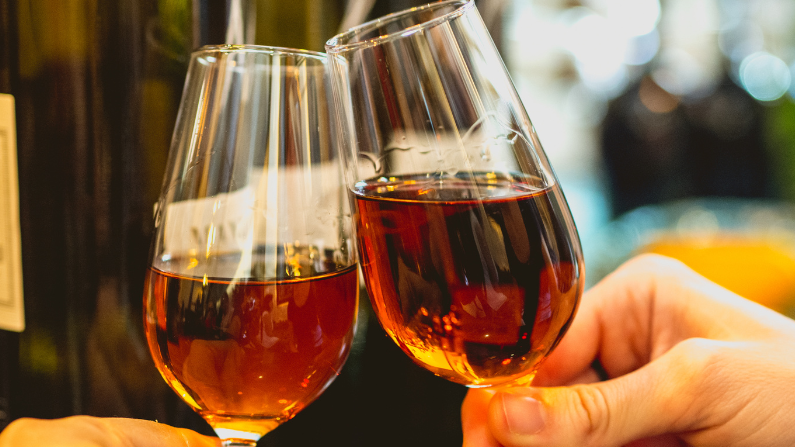
Oxidation is a touchy subject in the wine world. It dances between being a flaw and a highly-pursued trait of many fine wines. For a wine to be oxidized, it must be exposed to oxygen, either accidentally or intentionally.
First note, there’s a big difference between an oxidative wine and wine that’s been oxidized. Oxidative wines are deliberately exposed to oxygen to create layers of caramel, nut, and honey flavors. On the other hand, oxidized wines that have been mishandled can taste flat, dull, vinegary, and simply “off.”
In this post, I’ll break down what happens during the oxidation process, when it’s good or bad, and what it looks like when the opposite happens: reduction.
What happens during oxidation?
Oxidation occurs when the ethanol (alcohol) in wine is exposed to oxygen and converted into acetaldehyde. If you’ve ever frowned at a bag of brown apple slices in your lunch box or scraped the top layer off a fresh batch of guacamole, you know all about oxidation.
Let’s be clear: oxidation happens to every wine, at least a little bit. During fermentation, wines may be deliberately exposed to oxygen via pump overs, punch downs, lees stirring, or open-tank fermentation. This is usually done to circulate the yeast to speed up fermentation.
Once wines are racked into barrels, the porous nature of the barrels causes wine to evaporate out over time. Winemakers who don’t want over-exposure to oxygen will “top up” barrels with additional wine to minimize oxygen exposure.

When is oxidation bad?
Most wines on the market should not be exposed to much oxygen. Oxidation flattens the fruity flavor and aroma of wine, making it dull, unbalanced, and unpleasantly acidic.
Here’s a breakdown of bad reasons a wine may be oxidized:
- It’s been opened too long
A good bottle of wine should be consumed within 3-5 days. Longer, and the wine will begin to taste like vinegar and will lose its delicate fruit and floral aroma. (tip: drink an open bottle within a few days or use a Coravin to remove excess oxygen from the bottle)
- The cork dried out
If a bottle is stored upright, the cork will dry out and shrink, exposing the wine to oxygen. (tip: store bottles you want to age horizontally or upside down)
- It got too warm
Too much sunlight will cause free radicals to develop and quickly oxidize the wine. (tip: keep most wines at a consistent temperature between 55-65°F)
- Big temperature fluctuations
Moving wine from warm to cold temperatures can cause the pressure in the bottle to change, allowing oxygen to sneak in through the cork. (tip: if you put a bottle of white wine in the fridge to chill, then change your plans, keep the bottle in the fridge)
- Winemaking practices
Oxygen will inevitably seep in if the winemaker doesn’t top off barrels, close tanks, or add enough SO2.
- Overly aerated
Wine bottles that are left open for a long time or overly decanted wines can taste flat and lose their subtle fruity qualities. (tip: avoid decanting simple white wines or young red wines)

When is oxidation good?
When done right, oxygen adds an unmistakable richness and creates a fuller flavor profile. Oxidative wines are usually aged and prized not for their fruity flavor but for their dried fruit, caramel, nutty, and umami qualities.
Here’s a breakdown of how wines may be intentionally oxidized:
- Adding oxygen during fermentation
Deliberately pumping oxygen into a tank of fermenting grapes can help encourage unique flavors of honey, toasted nuts, and dried fruits.
- Oxidative aging
Aging wine in a porous vessel (barrels or clay amphora) allows oxygen to interact with the wine and can help soften bold reds to make them more well-rounded.
- Bottle aging
Even when properly stored, the cork will allow a small amount of oxygen to pass through. This is what causes aged wines to taste so different from when they were first bottled.
- Disgorgement
During the riddling and disgorgement process of making Champagne, a small amount of oxygen is introduced. This allows for subtle buttery and honey flavors to take shape as the wine ages in bottle.
- Decanting
Pouring a bottle of wine into a wide open container allows oxygen to interact with the wine and can help unravel “tight” or closed-off wines, revealing a bigger, more fruity flavor profile.

Examples of oxidative wines
Sherry
From the Jerez region of Spain, Sherry is a widely popular fortified wine that is carefully, slowly exposed to oxygen. Over time a cap or flor of dead yeast covers the wine, preventing extreme oxygen exposure. Depending on the age and level of sweetness, Sherry can taste of dried fruit, burnt honey, and creamy caramel.
Vin Jaune
From the Jura region of France, translating to “yellow wine.” This special class of white wines is made from 100% Savagnin grapes, aged in barrels similar to Sherry. These wines are not topped off; over time, they develop a yeast layer known as voile (similar to flor in Sherry). The finished wine is bone dry and tastes of brine, dried apricot, curry, and pine.
Tawny Port
Arguably, the best example of Port wine is Tawny Port. It’s aged 10-40 years in barrels, making for richly flavored fortified wines with strong dried fruit, nutty, crème brûlée flavors.
Madeira
This fortified wine from the Madeira islands off the coast of Portugal is purposely heated to exceptionally high temperatures, resulting in strong notes of toffee, butterscotch, and cocoa.

A word on reductive wines
Now that we’ve covered oxidation and oxidative wines let’s end on what the exact opposite of oxidative wines looks like… reductive wines.
Reductive wines are wines that have been devoid of exposure to oxygen. This is most commonly found in white wines or delicate red wines such as Gamay Noir or Pinot Noir.
Carbonic maceration is a popular form of making reductive wines. This process involves harvesting grapes and sealing them in a stainless steel tank. Over time, the chemical reaction in the grapes causes them to burst.
This allows fermentation to continue without overly handling the grapes, thereby preserving their delicate fruity, bright flavors. Beaujolais Nouveau is the most notorious wine made using carbonic maceration.
As opposed to nutty and rich, reductive white wines can be more mineral driven often with obvious sulfur character or notes of struck match.




Olivia is a Washington-based freelance writer with a Level 2 Award in wines from the Wine & Spirit Education Trust. She has a passion for all things food, wine, and travel, though her heart belongs to the Pacific Northwest. When she’s not sipping on a glass of Washington Cab., she’s usually bikepacking, crocheting, or chillin’ in the sun with her dog Tater.
IG: @liv_eatslocal
Website: liveatslocal.com


